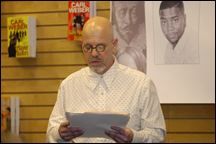
English professor and novelist Steve Tomasula offers students an unexpected approach to the study of literature.
I work against the idea of literature as a museum – where all the authors are dead,he says.People Im working with are alive – contemporary literature is an ongoing conversation, one that I try to put on the front burner.
With a respectful nod to traditional literature courses that typically end with works of the 1950s, Tomasula views his teaching of literature asan extension of tradition rather than a break from it.
He considers literature just one piece of the broader culture and incorporates contemporary artifacts – including film clips and visual art – in his teaching to add dimension and perspective to classic works.
I like to include other kinds of artists dealing with ideas, since literature doesnt happen in a vacuum,he says.
Monsters, Cyborgs, and Other Created Bodiesis a literature class based on the premise that authors throughout history have used the body as a metaphor through which to tell their stories and convey emotion and ideas.Students in this class read a broad spectrum of literary works related to the body theme, and Tomasula uses clips from films such asSaving Private Ryan,andJackass: The Movieto further illuminate the thematic study of different representations of the body.
One of the themes in the class isThe Body Through Time,and the required readings include the hypertext novelPatchwork Girl,by Shelly Jackson.
Its sort of a postmodern Frankensteinand takes Victorian assumptions and brings them into modern terms,explains Tomasula.
His method of integrating artifacts of the broader culture into literature extends beyond the classroom and takes hold of readers in his latest novel, titledVAS: An Opera in Flatland,(UniversityofChicago Press, 2004).
Described by American Book Review asthe most visually exhilarating fiction to appear in years,VASis replete with three-color graphics, foldout pages, drawings and typographic creativity. Using a wide sweep of representations of the body, from pedigree charts to genetic sequences, it tells the story of the inhabitants of Flatland who are able to step outside their lineage by rearranging the bodies of plants, animals and themselves.
Like the works studied in TomasulasMonsters, Cyborgs and Other Created Bodiescourse, the multi-layered novel examines how different ways of imagining the body generate different stories of power, gender, politics and self-identity.
The book is used as a metaphor for the body, the body for the book,Tomasula said.Its a narrative that refers to itself as well as the human body, and its told in opera, librettos and journalistic pieces.
Readers ofVAS,like his students, benefit from an experience that challenges the traditional notion of how literature can be imagined.
TopicID: 9707